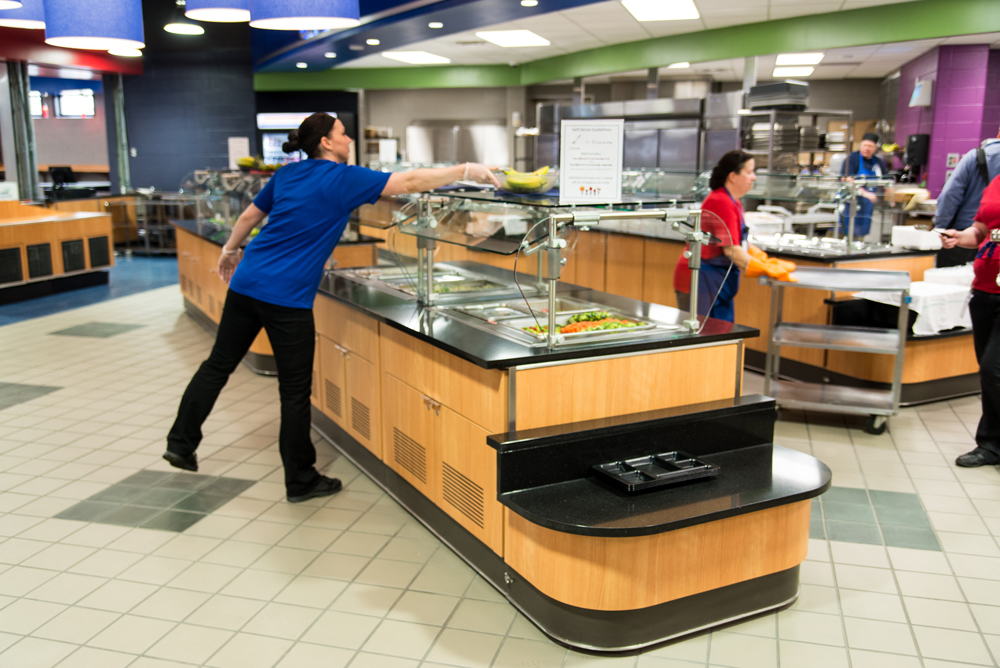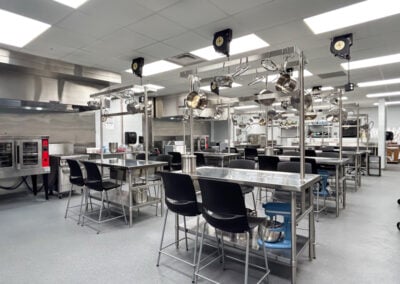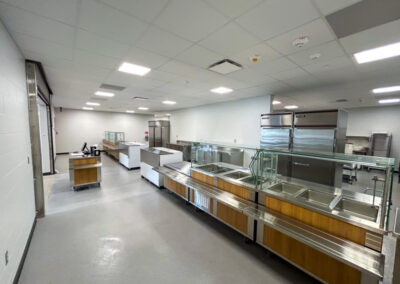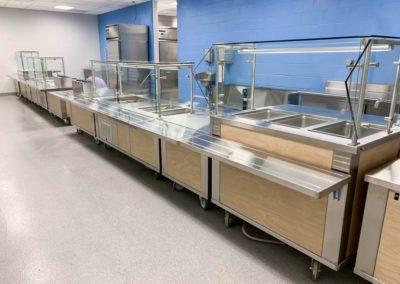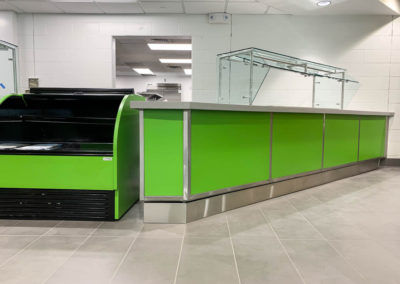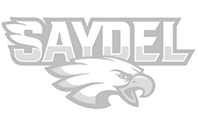K-12 School Cafeteria and Kitchen Design
SERVING YOUR AREA
Ready to improve or build your food service operations? Contact us to talk to one of our experts right away!
or call 800-899-6604
The Rapids Contract design team has been designing and building public school cafeterias and kitchens for decades. Our expertise enables us to build the most efficient kitchens and cafeterias, from start to finish, for your K-12 school district. We work with the school district’s budget and deadlines to deliver school cafeterias and kitchens that look great and function well for high-volume breakfast and lunch service.
Efficient Design and Equipment Saves Schools Time and Money
Budget-friendly school cafeterias and kitchens can be attractive as well as super efficient. We can turn your school cafeteria into an inviting place to deliver meals during lunch period. Plus, lunch staff will find relief in the kitchen systems and equipment we know will make their jobs easier.
Save energy while streamlining the kitchen workflow. Our LEED-certified designer can guide your school district toward the latest energy-efficient technology, including lighting and equipment. Rapids Contract makes selection and procurement of kitchen equipment easy, providing you with options that meet your budget and save you money over time.
Why Rapids Contract Is Different
K-12 School Cafeteria projects come in all different forms and require unique and exciting ideas to set them apart. However, every great project is born of a strong and time-tested process for delivery to schools. Our unrivaled cafeteria and kitchen design process delivers customized solutions to K-12 schools.
At Rapids, our commitment to quality is supported by our expertise and pursuit of excellence. Your trusted cafeteria and kitchen design team includes your project manager, LEED-certified interior designers, CFSP-certified consultants, architects, and general contractors. Our on-site management and coordination is one of the many ways our foodservice consultants go above and beyond to provide exceptional customer service.
Get Ideas From Experts in The Industry
Experience With All School Sizes
Experience Coordinating With the Trades
Through the years of building our kitchen and dining area designs, we have always been dedicated communicators throughout the entire process. To build or remodel a school kitchen and cafeteria, numerous trades and vendors will be required. Leave the coordination of those teams as well as permitting officials to Rapids Contract. We will maintain the project schedule to make sure your kitchen and cafeteria are operational in time for the first day of school.
Convenient Purchasing Portal
Procurement is easier with Rapids Contract’s convenient purchasing portal. Once your school district establishes a relationship with us, you receive access to a huge catalog of smallwares and other equipment at negotiated prices. We collaborate with foodservice agencies, such as Area Education Agencies and Co-Op Purchasing Connection, to fulfill your needs for equipment at negotiated prices. For more info, contact [email protected].
Rapids Contract is ready to help your school district with its kitchens and cafeterias. Contact us to learn more about K12 kitchen design.
Frequently Asked Questions for School Cafeterias
How long does it take to install a school cafeteria?
The time it takes to install a school cafeteria can vary widely based on several factors, including the size of the kitchen, the complexity of the design, the type of equipment being installed, local regulations and permits, the availability of contractors and skilled labor, and the efficiency of the installation process.
In general, smaller and less complex kitchens in an existing foodservice space might take a few weeks to a couple of months to install, while larger and more intricate kitchens could take several months. Here are some key factors that can influence the installation timeline:
1. Design and Planning: The design phase can significantly impact the installation time. If the kitchen’s layout and design are well-prepared in advance, it can help streamline the installation process.
2. Equipment Selection and Availability: The type of equipment needed for the kitchen can affect the timeline. If specialized or custom equipment is required, it might take longer to source and install.
3. Permits and Regulations: Obtaining necessary permits and complying with local regulations can sometimes be a time-consuming process that impacts the installation timeline.
4. Construction and Infrastructure: If any modifications or construction work is required to accommodate the kitchen, such as plumbing, electrical, or ventilation systems, this can add to the installation time.
5. Skilled Labor and Contractors: Availability of skilled contractors, electricians, plumbers, and other professionals can influence how quickly the installation can be completed.
6. Project Management: Efficient project management can help keep the installation on track and avoid delays.
7. Unforeseen Issues: Unexpected challenges or issues that arise during installation, such as equipment malfunctions or structural problems, can extend the timeline.
8. Size and Complexity: Larger kitchens with more intricate setups, multiple workstations, and specialized equipment can naturally take longer to install.
9. Coordination and Scheduling: Coordinating the various tasks involved in the installation, such as equipment delivery, construction work, and inspections, requires careful scheduling.
It’s recommended to work closely with a firm like Rapids who has solutions engineers, designers, project managers, project coordinators, and support teams experienced in commercial kitchen installations. we can provide a more accurate estimate based on the specific details of your project and help manage the process to ensure it’s completed as efficiently as possible.
How much does a school cafeteria cost?
The cost of setting up a school cafeteria can vary widely depending on several factors, including the size of the kitchen, the type of cuisine you’ll be preparing, the quality of equipment and materials you choose, location, and local regulations. Here are some of the major cost considerations:
1. Location: The cost of commercial real estate can vary greatly based on the region, city, and neighborhood where you plan to set up your kitchen.
2. Size and Layout: The overall square footage and layout of the kitchen will impact costs. A larger kitchen will require more equipment, materials, and space planning.
3. Equipment: The cost of commercial kitchen equipment varies based on the type and brand. High-quality, specialized equipment can be more expensive. Equipment includes ovens, stoves, refrigerators, freezers, fryers, grills, ventilation systems, dishwashers, and more.
4. Ventilation and Exhaust Systems: Proper ventilation and exhaust systems are crucial for a commercial kitchen to ensure air quality and safety. These systems can be a significant cost factor.
5. Utilities and Infrastructure: Costs associated with plumbing, electrical work, and gas lines installation or modifications need to be considered.
6. Construction and Renovation: If you’re building or renovating a space to accommodate the kitchen, construction costs can vary based on the extent of the work required.
7. Permits and Regulatory Compliance: Obtaining permits and complying with health and safety regulations may incur fees.
8. Interior Design and Finishes: The quality of finishes, such as flooring, countertops, and wall coverings, can impact costs.
9. Furniture and Fixtures: If you’re setting up a restaurant or eatery within the kitchen space, the cost of furniture and fixtures for the dining area should also be considered.
10. Labor Costs: Labor costs include not only the salaries of kitchen staff but also costs for installation, construction, and any specialized services needed.
11. Contingency: It’s wise to budget for unexpected costs that may arise during the setup process.
Due to the many variables involved, it’s challenging to provide an exact figure. However, to give you a rough idea, setting up a basic small-scale commercial kitchen could start around $50,000 to $100,000. Larger, more complex kitchens with high-end equipment and finishes could cost several hundred thousand dollars or even more.
To get a more accurate estimate for your specific situation, it’s recommended to consult with our commercial kitchen design and construction professionals. We can assess your needs, provide cost breakdowns, and help you plan a budget that aligns with your goals.
What layout options are available when designing a school cafeteria?
When designing a school cafeteria, the layout should prioritize efficiency, speed, and safety. There are several layout options to consider, each with its own advantages depending on the size of the space, the menu, and the workflow. Here are some common layout options:
1. Assembly Line or Linear Layout:
This layout resembles an assembly line, with different stations for each step of the food preparation process. It’s ideal for fast food chains with a limited menu of items that can be prepared quickly. The workflow progresses in a linear fashion, from order taking to food assembly.
2. U-Shaped Layout:
A U-shaped layout places the cooking equipment and prep stations along the three sides of a U shape, with the middle left open for movement. This allows cooks to access equipment and ingredients without having to cross paths frequently.
3. L-Shaped Layout:
In an L-shaped layout, the kitchen equipment and workstations are arranged along two adjacent walls in an L configuration. This can be effective for smaller spaces and helps streamline the workflow between cooking and preparation areas.
4. Island Layout:
An island layout positions equipment and stations in the center of the kitchen, allowing cooks to access equipment from all sides. It’s suitable for larger kitchens with ample space and can provide a more flexible workflow.
5. Zoned Layout:
This layout divides the kitchen into distinct zones, each dedicated to a specific task such as cooking, preparation, dishwashing, and storage. It’s efficient for larger kitchens and helps prevent congestion by keeping different tasks separate.
6. Open Kitchen Layout:
An open kitchen layout allows customers to see the food preparation process, which can add transparency and a sense of freshness. This layout requires careful organization to maintain a clean and presentable appearance.
7. Parallel Layout:
In a parallel layout, equipment and stations are placed along two parallel lines. This is useful for kitchens with a linear workflow, where tasks progress from one end to the other.
8. Zone and Flow Layout:
This layout combines zoned areas with a logical flow of food preparation. It ensures that tasks progress smoothly and avoids unnecessary backtracking.
9. Hybrid Layout:
Depending on the specific needs of your restaurant, a combination of different layouts can be used to optimize space and workflow. For example, a U-shaped layout for cooking and an assembly line for order preparation.
Remember that the layout should be tailored to your restaurant’s unique requirements, menu items, and anticipated customer flow. It’s important to consider factors like the placement of cooking equipment, prep stations, serving areas, and storage to create a seamless and efficient kitchen environment. Consulting with Rapids’ professional kitchen designers and solutions engineers can help you make informed decisions and create a layout that maximizes productivity and safety.
Where do you get your supplies from?
You can obtain foodservice equipment and supplies from various sources, both online and offline. Here are some common options:
Online Retailers: There are numerous online retailers that specialize in selling foodservice equipment and supplies but clearly Rapids Wholesale’s Webstore is the best in the business! In fact, over 75% of the K-12 school systems in our home state utilize our website for ordering equipment and smallwares. We work neighboring state school buying groups and independent schools as well! Our team can prepare a “market basket” of items your school uses most and provide negotiated discount pricing on those items! Reach out to find out more!
Restaurant Supply Stores: These are specialized stores that offer a wide range of commercial kitchen equipment and supplies. You can find everything from cooking appliances to utensils, furniture, and cleaning supplies. Rapids currently has Restaurant Supply Store locations in St. Paul, MN and Marion, IA.
Wholesale Distributors: Some distributors cater specifically to businesses in the food industry. They often offer bulk purchasing options and may have discounts for larger orders. Rapids Account Management Team is standing by to assist.
When sourcing foodservice equipment and supplies, consider factors like price, quality, warranty, and customer reviews. Compare options from different sources to make informed decisions that align with your budget and needs. Additionally, be aware of any local regulations or codes that might affect the type of equipment you can use in your commercial kitchen.
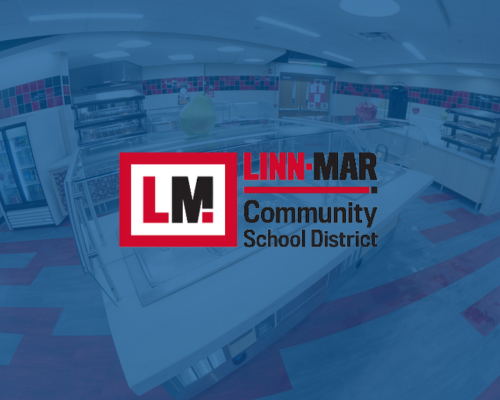
Previous Work – Linn-Mar High School
This project was a high-school cafeteria remodel completed September 2016 in Marion, IA.
This complete commercial kitchen and cafeteria remodel project was led by Luke Green, Rapids’ own DSR of the Month. He stated there was an immediate need to provide a more efficient service line. Prior to the renovation, students were waiting up to 25 minutes to get through the line leaving them only 5 minutes in their 1/2-hour lunch periods to actually sit down and eat.
Previous Work – Maple Grove Elementary School
Maple Grove Elementary is a new construction project that is part of Cedar Rapids School District’s Phasing Program. This is one of many new facilities Rapids has been awarded that is being constructed to update and modernize the district’s aging school infrastructure. The ultimate goal of the program is to build Future-Ready Facilities including 10 new elementary schools and renovate 3 others over the next 15-20 years.
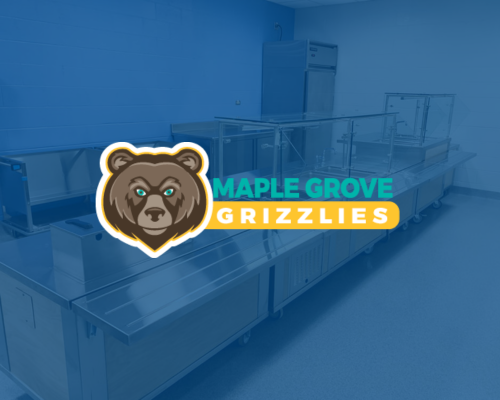
LET'S FIND YOUR SOLUTION
Rapids Contract & Design serves the United States with locations in Iowa, Minnesota, and Missouri. Our experts are ready to assist with your foodservice needs—contact us for support, Monday through Friday, 8 AM to 5 PM CST.
or call (800) 899-6604

